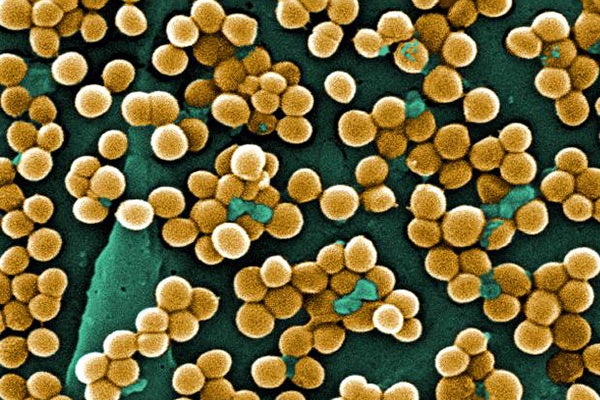|
November 14, 2012
Glycine plays key link in a deadly staph bacteria, Stanford researchers discover
A new study from Stanford's Department of Chemistry reveals that the cell wall structure of Staphylococcus aureus, a bacterium responsible for a broad range of diseases, depends on growth stage and nutrient availability. By Melissa Pandika

The researchers' work on Staphylococcus aureus could eventually change the way bacterial infections are treated. (Photo: MicrobeWiki.Kenyon.edu)
Chemistry graduate student Xiaoxue Zhou had carried out an experiment to find out how antibiotics affect cell wall structure in Staphylococcus aureus, a bacterium responsible for a slew of ailments from food poisoning to boils and abscesses. As she sifted through the data, she uncovered a peculiar result that could ultimately change how bacterial infections are treated.
The study in Biochemistry shows that the Achilles' heel of these germs may be the nutrient glycine, which keeps intact the cell walls of the staph bacteria that cause acne in teenagers and sneak up on elderly hospital patients.
"This started very serendipitously," said Lynette S. Cegelski, an assistant professor of chemistry. The researchers relied on a highly sensitive technique called solid-state nuclear magnetic resonance, allowing them to study the chemical structure of a major component of the bacterial cell wall – a large, cage-like molecule called peptidoglycan.
In S. aureus, peptidoglycan units are linked together by a bridge made from molecules of the amino acid glycine, forming a dense, sturdy cell wall that maintains cellular shape and integrity. Shortening of this bridge prevents peptidoglycan linking. Previous research has shown that this shortening impairs bacterial growth and overcomes resistance to the powerful antibiotic methicillin, the defining characteristic of the "hospital bug" MRSA, or methicillin-resistant S. aureus.
While poring over the solid-state NMR results, Zhou noticed a peak in the readings that appeared higher at later growth phases of the bacteria. Further analysis showed that the peak corresponded to a structure missing a glycine bridge.
"It was a control experiment, and we started chasing it down," Zhou said.
'Tipping nature off balance'
While earlier studies already showed that cell wall structure varies with growth phase, what caused these differences remained a mystery. Zhou’s NMR results hinted at glycine levels, showing that they also depend on growth phase.
Bacteria use glycine as they divide at an exponential rate, which slows and eventually plateaus as the cells use up nutrients and space. At that point, called the stationary phase, the bacteria have depleted the glycine needed to assemble the cell wall bridges.
Zhou and Cegelski proved that glycine availability was the "master dial" controlling cell wall structure. As expected, when they turned the dial themselves by starving S. aureus of glycine, peptidoglycan molecules with missing bridges appeared earlier. Supplementing the cells with glycine resulted in relatively normal peptidoglycan with only a few missing bridges.
"It's always the case when you tip nature off balance a little bit, in this case with changing nutrient conditions, you discover something neat," Cegelski said.
Previous studies have traced alterations in peptidoglycan's structure to antibiotics or genetic changes and have focused on bacteria still undergoing exponential division, when they're thought to be most vulnerable to antibiotics. Zhou's and Cegelski's study is the first to explore the role that nutrient availability plays in cell wall assembly in bacteria in the stationary phase.
"People normally only study (bacteria) in the exponential phase … but we think we need to check all the different conditions," Zhou said. "That's why we looked at the stationary phase, which is more relevant in persistent and biofilm-associated infections."
"Bacteria tend to grow as communities, Cegelski explained. They form complex arrangements called biofilms, which are associated with serious, persistent infections, like those associated with cystic fibrosis.
New strategies
Bacteria can produce their own glycine, so they could theoretically wait until they've made enough to assemble complete peptidoglycan units, with full-length bridges, before transporting them to the cell surface. Instead, Zhou and Cegelski observed the opposite, with bacteria transporting incomplete units that lack the ability to crosslink.
The next step is to determine whether growing the cells in environments with even less glycine would cause them to transport more of these incomplete peptidoglycan units to their surfaces, eventually causing the cell wall to weaken and the bacterium to burst.
"If you can figure that out … how to mimic that glycine deprivation and encourage the transport of stems without bridges, in a sense molecularly, you could exploit that to develop an antibacterial strategy," Cegelski said.
"The results are just as exciting as what we were originally after," she said, adding that researchers should "always be ready or prepared for these unanticipated discoveries that might lead your research to new heights that you hadn't necessarily charted out."
Melissa Pandika is an intern with the Stanford News Service.
-30-
|